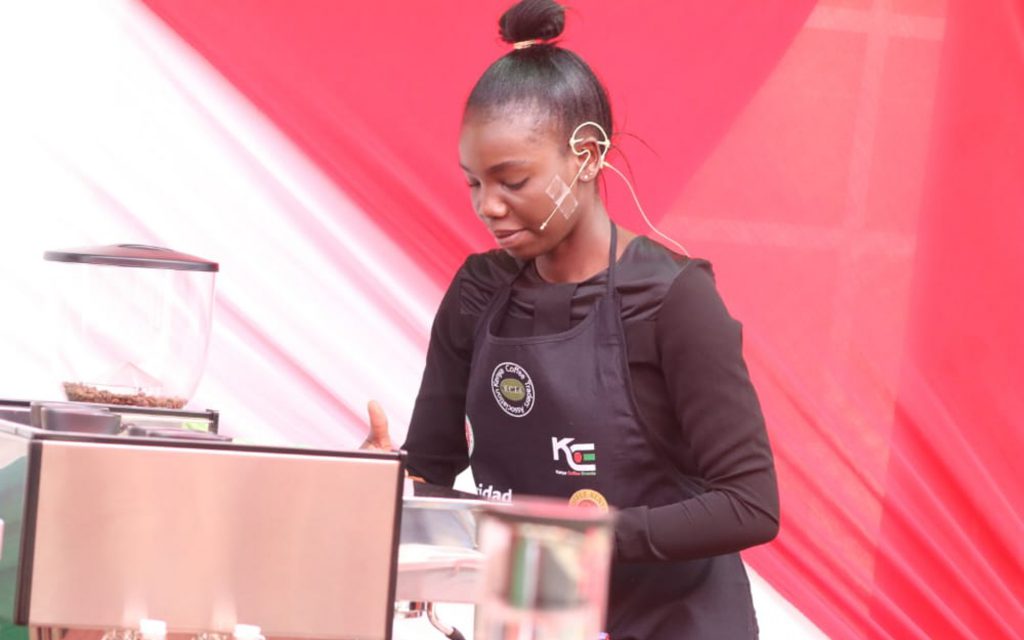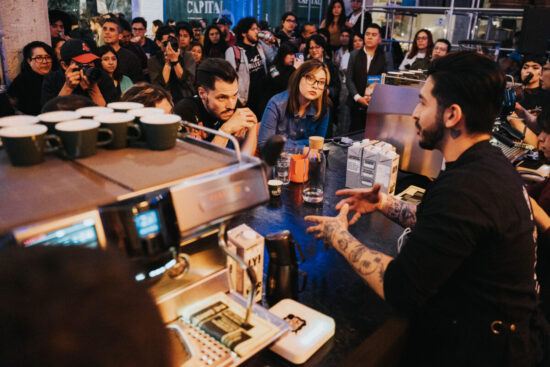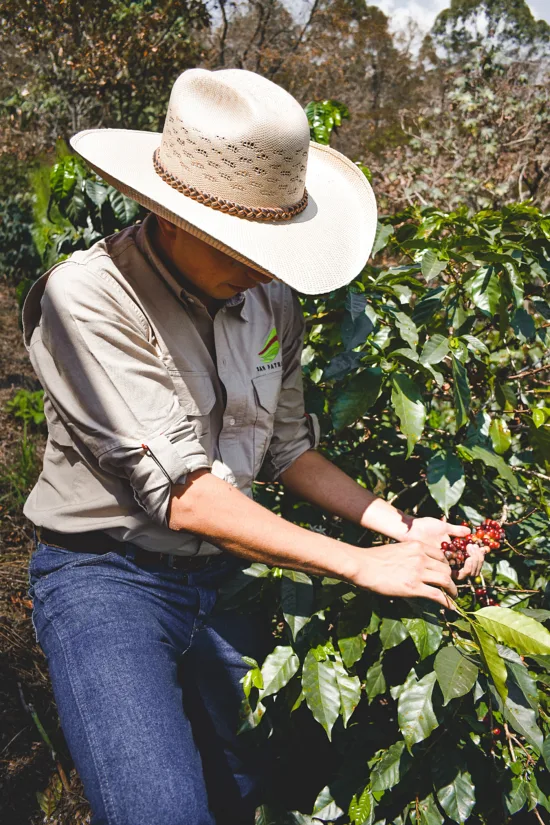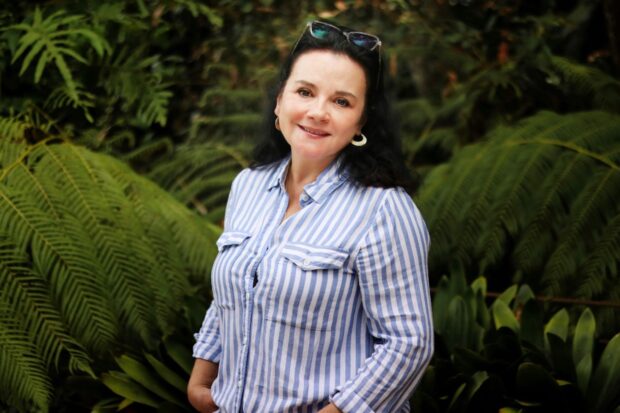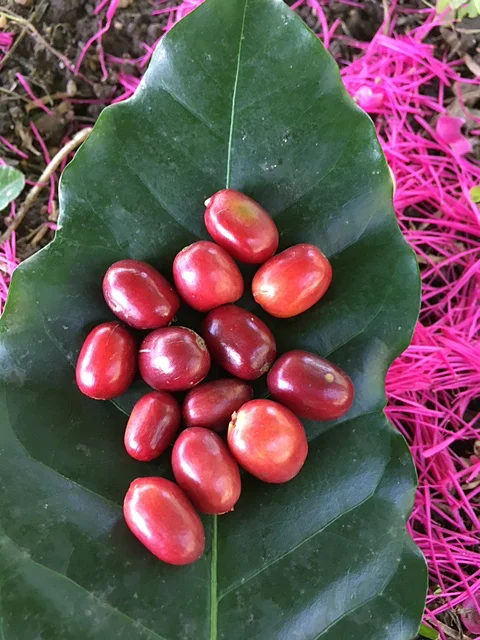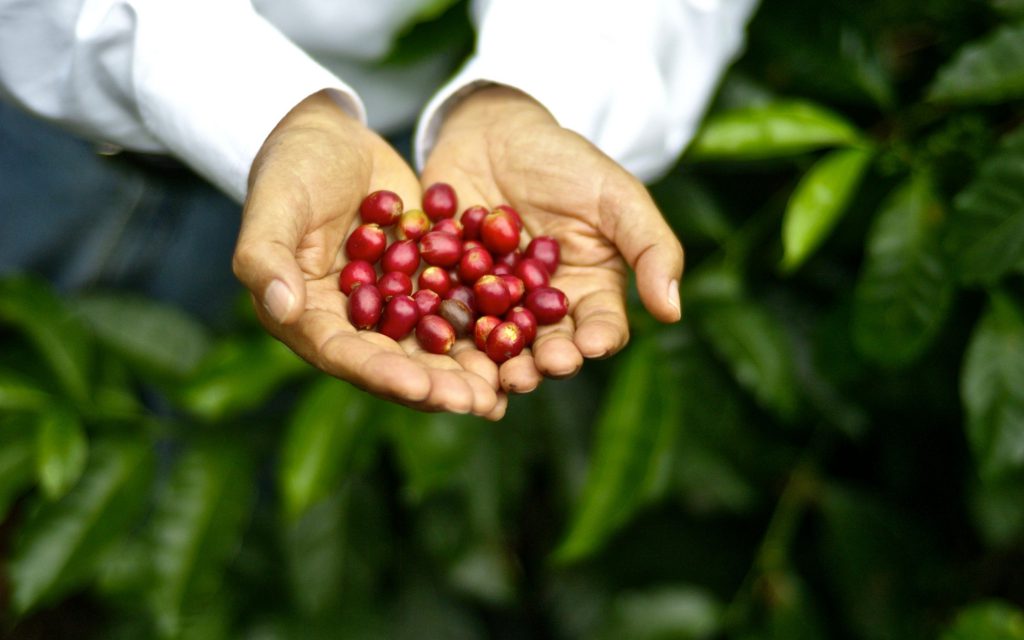The Malaysian capital is often visited in a hurry, but visitors who take the time to explore will discover a welcoming city, thanks in part to its friendly specialty cafés. BY TANYA NANETTI SENIOR ONLINE CORRESPONDENT Photos by Tanya Nanetti Kuala Lumpur, the capital...
Conflict in the Red Sea: Why coffee roasters need to prepare for shipping delays
Conflict in the Red Sea: Why coffee roasters need to prepare for shipping delays
Conflict in the Red Sea: Why coffee roasters need to prepare for shipping delays
Conflict in the Red Sea: Why coffee roasters need to prepare for shipping delays
Conflict in the Red Sea: Why coffee roasters need to prepare for shipping delays
Conflict in the Red Sea: Why coffee roasters need to prepare for shipping delays
Thread Coffee Roasters Opens Tailor-Made Roastery in Baltimore
The interwoven actions of Thread Coffee Roasters in Baltimore are finding exponentially more space this week with the grand opening of a brand-new production roastery and training lab. The worker-owned...
Toronto’s Pilot Coffee Roasters Acquiring Bridgehead Coffee for $3.6 Million
Toronto, Ontario-based specialty coffee roaster and retailer Pilot Coffee Roasters is acquiring Ottawa-based Bridgehead Coffee in a deal worth approximately US$3.6 million. Bridgehead, which has 21 coffee shop locations throughout...
Baking With Coffee For Beginners
This article is from the coffee website Sprudge at http://sprudge.com. This is the RSS feed version. Where to get started when introducing coffee to your bakes.
Bypass coffee brewing: How can it improve extraction?
There is a lot of science to brewing coffee. Whether knowingly or unknowingly, we trigger – and try to control – an almost endless number of chemical reactions to achieve the perfect extraction. To do so, we have to tweak different variables – such as grind size,...
Hawaiian Legislators Introduce Bills for Stricter Coffee Labeling
Legislators representing the Kona district of Hawaii have introduced a series of bills that would require more strict labeling requirements for single-origin coffees and blends containing Hawaiian-grown coffees. Some Kona...
New AFCA Director Gilbert Gatali on the 20th African Fine Coffees Conference
As the African Fine Coffees Association (AFCA) prepares for the 20th iteration of its flagship event, the African Fine Coffees Conference and Exhibition, the group is operating under new executive...
Philadelphia’s Café Don Pedro Seeks to Build Up Small Businesses
A Dominican-owned coffee roasting company called Café Don Pedro recently launched in Philadelphia with ambitions for direct trading and boosting more Latino-owned small businesses throughout its supply and distribution networks....
How much do you over-extract coffee in recipes?
This is sort of an odd question, but it's not a troll. While I love brewing specialty coffee, I also enjoy frappes (with or without ice cream). A major hurdle when using my espresso has been that while the final beverage tastes fine, the coffee is just too high...
Sprudge Maps Spotlight: Little Bear Coffee In Albuquerque, NM
This article is from the coffee website Sprudge at http://sprudge.com. This is the RSS feed version. Little Bear Coffee in Albuquerque, New Mexico.
Starbucks Will Hold their Own Barista Championship Thank You Very Much
This article is from the coffee website Sprudge at http://sprudge.com. This is the RSS feed version. The North American Barista Championship is expected to host over 15,000 Starbucks hourly workers.
What I Learned from My First Tea Ceremony
After taking in a brief moment of a tea ceremony in Thailand, I finally had the chance to participate in the full experience recently in Malaysia. BY TANYA NANETTI SENIOR ONLINE CORRESPONDENT Photos by Tanya Nanetti In the years that I worked as a barista in a café,...
Why it’s easier for wealthier producers to grow specialty coffee
It takes money – and sometimes a lot – to grow specialty coffee. Producers not only need to continuously maintain and improve quality and yields, but they also have to invest back into their farms. Whether it’s replacing equipment and machinery or planting more...
Does specialty Robusta exist?
Hello! Has anyone tried 'specialty robusta'? I work with specialty cacao, and I often observe Robusta shrubs being cultivated at lower altitudes alongside cacao trees. Some farmers are experimenting with carbonic maceration to enhance the marketability of...
[MOD] The Daily Question Thread
Welcome to the daily /r/Coffee question thread! There are no stupid questions here, ask a question and get an answer! We all have to start somewhere and sometimes it is hard to figure out just what you are doing right or doing wrong. Luckily, the /r/Coffee community...
The Sprudge Guide To Coffee Shops In Vancouver, BC
This article is from the coffee website Sprudge at http://sprudge.com. This is the RSS feed version. Where to drink coffee in Vancouver, British Columbia, Canada.
Coffee Machine (High density use)
Hi everyone, i am new in this coffee world and i am looking to buy me a coffee machine to setup a small business. I am looking for affordable machine that is good for high density use. Im open for any recommendation and opinion. Thank you guys! Here is what ive found...
Which to buy first?
Hi there, mostly a lurker until now. I'm trying to incentivize myself towards some goals and decided that rewarding myself with a better coffee set up upon reaching those goals would be great. I plan to get myself one nice thing when I reach my intermediate goal...
[MOD] The Official Deal Thread
Welcome to the /r/Coffee deal and promotional thread! In this weekly thread, industry folk can post upcoming deals or other promotions their companies are holding, or promote new products to /r/Coffee subscribers! Regular users can also post deals they come across....
The London Coffee Festival has just more than doubled its ticket price
Last year: £18 This year: £38 Unbelievable. It’s the same venue and same setup. I’m just an ordinary coffee fan and every year I spend a lot buying roasts and equipment there. submitted by /u/gahgeer-is-back [link] [comments]
Explain making good coffee to me like I’m 5.
Hi everyone, I’m not new to drinking coffee, but I’d like to start making it (well) at home myself. I’m totally clueless. I have an old Keurig that I rarely use, as well as a basic Mr. Coffee maker. Usually I buy dark roast ground coffee (I do like a good, strong cup...
Seeking instant test for rough caffeine level in coffee
About once a month, some inattentive barista gives me regular coffee by mistake, which is a bummer. I drink decaf. So when I get coffee at a cafe, I'd like to do an instant test of the rough caffeine level by dipping a strip into the coffee. Something analogous...
Questions/thoughts on cardamom-forward "thermal shock" processed coffees.
Hey everyone, Having a cup of Buttercream from September roasters and got to thinking. This is the second thermal-shock processed coffee I have had with this huge, distinctive cardamom note (The other being DAK milky cake which is also from Colombia, but from a...
Third Wave Coffee brands
Greetings to all, I am reaching out to this knowledgeable community with a query regarding the recognition of coffee brands within the third wave coffee movement. Is there an existing, publicly accessible list that categorizes and acknowledges coffee brands as part of...
Conflict in the Red Sea: Why coffee roasters need to prepare for shipping delays
Like many other industries, conditions in the coffee supply chain can change quickly, and in turn, have a huge impact on all actors and stakeholders. Price volatility is one of the more pertinent – which is influenced by many factors. These include fluctuations in supply and demand, extreme or unexpected weather events, global economic downturn, and social or political unrest.
Additionally, these factors can also affect shipping coffee from producing countries to export markets. We saw this with Covid-19, which caused the freight industry to collapse and shipping companies to massively reduce their capacities. But with demand for coffee only growing during the pandemic, coffee stockpiles soon started to reach record lows.
Most recently, however, conflict in the Red Sea (a narrow inlet of the Indian Ocean in between Africa and Asia) and escalating political tension in the Middle East could have a huge impact on global trade.
“Recent attacks on commercial vessels transiting the Red Sea have already started to disrupt key shipping routes, eroding slack in supply networks, and increasing the likelihood of inflationary bottlenecks,” the World Bank stated in its latest report.
Ultimately, this means the coffee supply chain is highly likely to be affected – so roasters need to best prepare.
I spoke to Betiel Medhanie, East Africa Logistics Manager at Sucafina, to find out how.
You may also like our article on why it becomes more expensive to ship coffee.


What’s happening in the Red Sea?
The current conflict in the Red Sea – which separates the coasts of Egypt, Sudan, and Eritrea from those of Saudi Arabia and Yemen – is incredibly complex and hard to unpack.
In a more immediate sense, it largely stems from Israel’s ongoing war in Gaza, which first started in early October 2023. Since then, over 25,000 Palestinian civilians have tragically been killed. This conflict also has its own long and complicated history dating back to World War One.
In response to Israeli attacks in Gaza, the Houthis – a political and military organisation in Yemen – have started to attack commercial shipping vessels travelling through the Red Sea. Members of the group have also boarded or hijacked cargo ships, although no serious injuries or deaths have been announced so far.
To avoid the conflict as much as possible, shipping companies like Maersk, Hapag-Lloyd, and MSC have halted or rerouted their vessels. According to the Atlantic Council, seven of the ten largest shipping companies have now suspended operations in the Red Sea.
How will the conflict affect global trade?
Simply put, the Red Sea is one the most important trade routes in the world. In a recent article, the Guardian stated about 12% of global trade passes through the Red Sea, including 30% of global container traffic. This equates to billions of dollars of goods passing through this route every year.
So with many freight companies avoiding the Red Sea and rerouting around the Cape of Good Hope (on the southern tip of Africa), total shipping times will increase by a few weeks. Moreover, shipping companies who choose to travel through the conflict zone are also facing higher insurance risk premiums. Either option comes with its own unique challenges and uncertainties.
There have been efforts to stop the attacks on and hijacking of cargo ships, including the formation of the Operation Prosperity Guardian coalition. But as of now, the conflict is still ongoing.


Impact on the coffee supply chain
The vast majority of the world’s coffee supply is transported from producing countries to export markets by cargo ships. This means many green coffee buyers and roasters are sure to be affected by the conflict in the Red Sea – mainly as a result of ensuing delays and higher shipping prices.
“Most carriers have paused service or rerouted vessels from the Bab-el-Mandeb Strait because of the continuing attacks on vessels there,” Betiel says. “Those who have continued service have introduced a war risk surcharge and declared force majeure.”
This is a common clause in contracts which essentially ensures both parties are not liable to fulfil their obligations when an extraordinary event or circumstance occurs beyond their control, including conflict.
“The diversion is causing more traffic in the Suez Canal and in general, we’re seeing transit delays of two to three weeks and slow container turnover,” Betiel explains. “If this continues, we anticipate that reduced capacity could trigger increased rates on top of the already implemented surcharges.”
Drawing comparisons with the pandemic
Shipping delays aren’t an uncommon occurrence in any industry. The last time we saw disruptions this significant, however, was during Covid-19.
With so many businesses forced to close, out-of-home coffee consumption took a huge hit. But this was offset with a simultaneous rise in at-home consumption. In the months following the pandemic as the global economy bounced back, demand for coffee and other consumer goods skyrocketed.
Resultantly, so that businesses could replenish their stocks to normal levels, there was a historic increase in the number of cargo ships coming into ports. What’s more, with social distancing measures in place at the time, port staff had to unload freight at a much slower rate – delaying shipments by weeks.
This led to unprecedented bottlenecks and disruptions across many supply chains, including in the coffee sector.
The problem was exacerbated even further in late March 2021 when the 400 metre-long Ever Given cargo ship blocked the Suez Canal for almost a week. At the time, it was carrying some 18,300 containers. The unintentional blockade also delayed the movement of 369 other ships which were unable to pass through the canal – resulting in an estimated loss of US $15 million per day for affected businesses.
Effectively, container space then became more competitive, which caused shipping prices to rise dramatically. In July 2021, a Bloomberg article stated the price of a single shipping container travelling from Brazil to the US had reached around US $4,000 – double the normal rate. Other reports at the time suggested containers travelling from Shanghai to the Netherlands sold for US $10,000, which is more than a 540% increase.
Roasters (especially smaller ones with less inventory on hand) then had to absorb the costs themselves, or raise their prices and pass them onto the end consumer.


How can coffee roasters best prepare for shipping delays?
In the years since the pandemic, we have seen how the coffee industry has remained resilient and managed to adapt to the ensuing challenges. So given that the scale of the conflict in the Red Sea isn’t as comparable to that of a global pandemic, there’s hope that recent disruptions will be more manageable for roasters and green buyers.
That doesn’t mean, however, that roasters shouldn’t prepare for shipping delays and increased costs as much as they can.
“We suggest that roasters contact their suppliers to review new arrival dates,” Betiel says. “Roasters should expect at least an additional two to three weeks for most shipments to arrive. It’s helpful to subscribe to weekly arrival updates on your importer’s website or with your trader.”
Maintaining green coffee quality will be one of the biggest priorities. The longer it takes coffee to reach its import destination, the more likely it is that quality will drop. Green coffee, however, technically stays fresh for up to a year – so delays of two to three weeks shouldn’t cause too many serious issues.
“Check your inventory levels regularly and estimate your consumption far in advance to account for slower arrival times,” Betiel tells me. “Additionally, check out spot offerings if you need last minute coffee and subscribe to newsletters to receive important information, such as monthly logistics reports.”
Dealing with increased costs
Undoubtedly, there will be financial repercussions of the conflict in the Red Sea and its impact on global trade. And with many coffee businesses still facing higher energy and food costs – tightening already slim profit margins – it’s likely that end consumers will also have to pay more.
It’s a difficult balancing act for roasters. They need to make sure they pay producers fairly for their coffee, while also not passing down too many extra costs to consumers.
Ultimately, communication and transparency are key. Although it’s more difficult than ever to provide customers with accurate timescales and updates, they will only help to strengthen partnerships and relationships.


Logistical issues are certainly a concern, but industry can still be manage them effectively with plenty of preparation.
While it seems that shipping delays will be persistent for another few months at least, roasters and green buyers should strive to remain resilient and adaptable.
Enjoyed this? Then read our article on logistical challenges in the coffee sector.
Perfect Daily Grind
Want to read more articles like this? Sign up for our newsletter!
The post Conflict in the Red Sea: Why coffee roasters need to prepare for shipping delays appeared first on Perfect Daily Grind.








